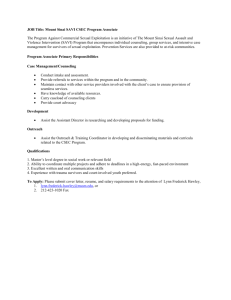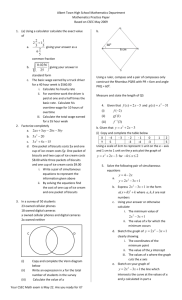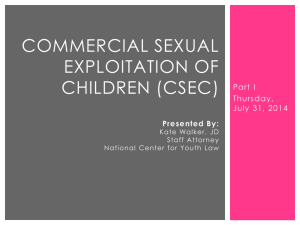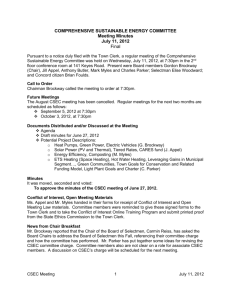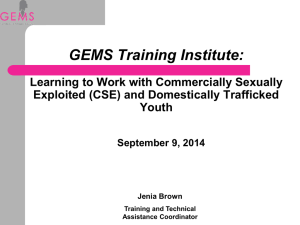Computing Security - Rochester Institute of Technology
advertisement
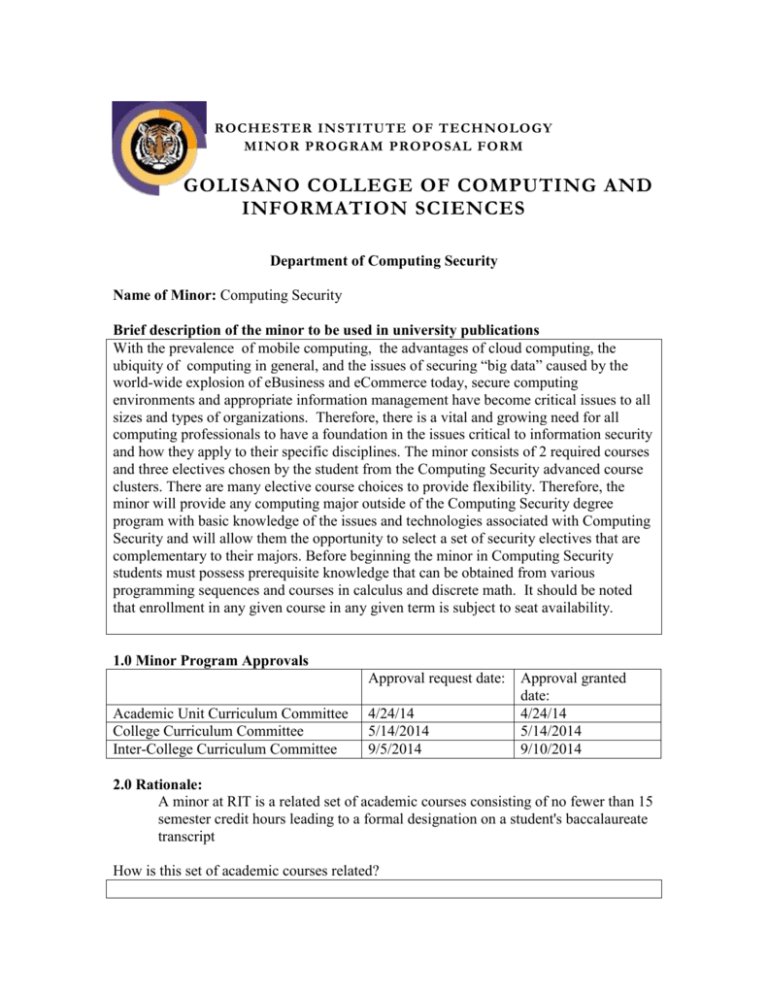
ROCHESTER INSTITUTE OF TECHNOLOGY MINOR PROGRAM PROPOSAL FORM GOLISANO COLLEGE OF COMPUTING AND INFORMATION SCIENCES Department of Computing Security Name of Minor: Computing Security Brief description of the minor to be used in university publications With the prevalence of mobile computing, the advantages of cloud computing, the ubiquity of computing in general, and the issues of securing “big data” caused by the world-wide explosion of eBusiness and eCommerce today, secure computing environments and appropriate information management have become critical issues to all sizes and types of organizations. Therefore, there is a vital and growing need for all computing professionals to have a foundation in the issues critical to information security and how they apply to their specific disciplines. The minor consists of 2 required courses and three electives chosen by the student from the Computing Security advanced course clusters. There are many elective course choices to provide flexibility. Therefore, the minor will provide any computing major outside of the Computing Security degree program with basic knowledge of the issues and technologies associated with Computing Security and will allow them the opportunity to select a set of security electives that are complementary to their majors. Before beginning the minor in Computing Security students must possess prerequisite knowledge that can be obtained from various programming sequences and courses in calculus and discrete math. It should be noted that enrollment in any given course in any given term is subject to seat availability. 1.0 Minor Program Approvals Approval request date: Academic Unit Curriculum Committee College Curriculum Committee Inter-College Curriculum Committee 4/24/14 5/14/2014 9/5/2014 Approval granted date: 4/24/14 5/14/2014 9/10/2014 2.0 Rationale: A minor at RIT is a related set of academic courses consisting of no fewer than 15 semester credit hours leading to a formal designation on a student's baccalaureate transcript How is this set of academic courses related? We propose this minor to complement the existing computing majors in GCCIS as well as computing related majors in other colleges at RIT such as Computing Engineering and MIS. The required courses are from the core of the Computing Security BS degree. The advanced electives in the Computing Security BS are organized in thematic clusters. Each student pursuing this minor would select three course from one of our eight clusters for which they have the pre-requite knowledge and that they feel complements their major. 3.0 Multidisciplinary involvement: If this is a multidisciplinary minor spanning two or more academic units, list the units and their role in offering and managing this minor. Not Applicable 4.0 Students ineligible to pursue this minor: The purpose of the minor is both to broaden a student's college education and deepen it in an area outside the student’s major program. A minor may be related to and complement a student’s major, or it may be in a completely different academic/professional area. It is the responsibility of the academic unit proposing a minor and the unit’s curriculum committee to indicate any home programs for which the minor is not a broadening experience. Please list below any home programs whose students will not be allowed to pursue this minor, provide the reasoning, and indicate if this exclusion has been discussed with the affected programs: Students matriculated in the BS in Computing Security or any BS/MS degree program that includes the BS in Computing Security are prohibited from pursuing this minor, as ‘[t]he purpose of the minor is both to broaden a student’s college education and deepen it in an area outside the student’s major program.” No other programs are excluded. 5.0 Minor Program Structure, Sequence and Course Offering Schedule: Describe the structure of the proposed minor and list all courses, their anticipated offering schedule, and any prerequisites. All minors must contain at least fifteen semester credit hours; At least nine semester credit hours of the minor must consist of courses not required by the student's home program; Minors may be discipline-based or interdisciplinary; In most cases, minors shall consist of a minimum of two upper division courses (300 or above) to provide reasonable breadth and depth within the minor; 2 As per New York State requirements, courses within the minor must be offered with sufficient frequency to allow students to complete the minor within the same time frame allowed for the completion of the baccalaureate degree; Provide a program mask showing how students will complete the minor. Narrative of Minor Program Structure: I) Students must satisfy the following prerequisites (1): a) A two-course introductory programming sequence, such as one of the following: CSCI 141 (Computer Science I) and CSCI 142 (Computer Science II) (the standard requirement) ISTE 120 (Computational Problem Solving in the Information Domain I) and ISTE 121 (Computational Problem Solving in the Information Domain II) ISTE 100 (Computational Problem Solving in the Network Domain I) and ISTE 101 (Computational Problem Solving in the Network Domain II) IGME 105 (Game Software Development I) and IGME 106 (Game Software Development II) CPET 121 (Computational Problem Solving I) and CPET 321 (Computational Problem Solving II) Or an equivalent sequence as determined by the Computing Security minor advisor b) A two-course Calculus sequence, such as one of the following: MATH 181 (Project-Based Calculus I) and MATH 182 (ProjectBased Calculus II) (the standard requirement) Or an equivalent sequence as determined by the Computing Security minor advisor c) A course in Discrete Mathematics, such as one of the following: MATH 190 (Discrete Mathematics for Computing) (the standard requirement) (note, this course is one of the prerequisites for CSCI 250 which may be required by the advanced course cluster selected by the student. MATH 192 (Discrete Mathematics and Introduction to Proof) MATH 131 (Discrete Mathematics) Or an equivalent course as determined by the Computing Security minor advisor II) Students must complete the following two required courses: CSEC 101 Fundamentals of Computing Security CSEC 362 Cryptography and Authentication or CSCI 462 Introduction to Cryptography III) Students will complete the Computing Security minor by taking three additional Advanced Computing Security courses for which they have the prerequisites. Many of the courses listed in the Computing Security 3 Advanced Clusters for which the student has the pre-requisites may be taken as part of the minor but two of the three courses must be offered from the Computing Security department. We will not define all of the possible combinations of Computing Security courses that might be used to complete this minor, rather, we will seek to help students create a collection of courses that are appealing and useful to their specific goals through advisement. The following course table demonstrates the feasibility of students being able to design a viable Computing Security minor that meets “all” of the stated minor requirements. It should be noted that enrollment in any given course in any given term is subject to seat availability. Course Number & Title CSEC – 101 Fundamentals of Computing Security CSEC – 362 Cryptography and Authentication or CSCI – 462 Introduction to Cryptography CSEC 461 Computer System Security CSEC 462 Network Security and Forensics CSEC 463 Sensor Network Security CSEC 465 Network and System Security Audits CSEC 466 Introduction to Malware CSEC 467 Mobile Device Security & SCH Required Optional Fall Spring Annual/ Biennial Prerequisites 3 X X X A NONE A CSEC 362:CSEC 101 MATH131/ CSCI 462: MATH-190 CSCI-243 A CSEC 101 NSSA 322 A CSEC 101 NSSA 241 NSSA 242 3 X X X 3 X X 3 X X 3 X X A NSSA 242 CSEC 362 CSCI 242 X X A NSSA-221 NSSA 241 3 3 X X X A CSEC 362 CSEC 363 NSSA 322 X X X A NSSA 221 3 4 Forensics CSEC 468 Risk 3 Management for Information Security CSEC 470 3 Covert Communications CSEC 471 Penetration Testing 3 CSEC 473 Cyber Defense Techniques 3 CSEC 474 Unix Based System Forensics CSEC 475 Windows System Forensics CSEC 476 Malware Reverse Engineering CSEC 477 Disaster Recovery Planning CSEC 478 Advanced Mobile Device Forensics CSEC 479 Advanced Mobile Device Security CSCI 455 Principles of Computer Security 3 X X A X X A X X A X X X X NSSA 221 3rd year standing 4th yr standing & permission of instructor 3rd yr standing within GCCIS A 3rd Yr standing within GCCIS A NSSA 221 A NSSA 221 A CSCI 250 CSEC 466 3 X X 3 X X 3 X X A 3rd year standing in GCCIS X X A CSEC 467 A CSEC 467 A CSCI 251 3 3 X X 3 X X 5 CSCI 464 Xtreme Theory CSCI 531 Introduction to Security Measurement CSCI 532 Introduction to Intelligent Security Systems SWEN 331 Engineering Secure Software 3 SWEN 467 Hardware/Softw are Co-Design for Cryptographic Applications 3 X X A MATH 190 CSCI 142 X X A CSCI 351 X X A CSCI 331 A SWEN 261 one completed co-op A SWEN 261 CSCI 462 3 3 3 X Total credit hours: X X X 15 Prerequisite Reference List: CSEC 101: Fundamentals of Computing Security CSEC 362: Cryptography and Authentication CSEC 363: Cyber Security Policy and Law CSEC 466: Introduction to Malware CSEC 467: Mobile Device Security and Forensics CCSI 242: Computer Science for Transfer Students CSCI 243: The Mechanics of Programming CSCI 250: Concepts of Computer Systems CSCI 251: Concepts of Parallel and Distributed Systems CSCI 331: Introduction to Intelligent Systems CSCI 351: Data Communications and Networks MATH 131: Discrete Mathematics MATH 190: Discrete Mathematics for Computing NSSA 221: System Administration I NSSA 241: Introduction to Routing and Switching NSSA 242: Wireless Networking NSSA 322: System Administration II SWEN 261: Introduction to Software Engineering 6 Minor Course Conversion Table: Quarter Calendar and Semester Calendar Comparison Directions: The tables on this page will be used by the registrar’s office to aid student’s transitioning from the quarter calendar to the semester calendar. If this minor existed in the quarter calendar and is being converted to the semester calendar please complete the following tables. If this is a new minor that did not exist under the quarter calendar do not complete the following tables. Use the following tables to show minor course comparison in quarter and semester calendar formats. Use courses in the (2011-12) minor mask for this table. Display all required and elective minor courses. If necessary clarify how course sequences in the quarter calendar convert to semesters by either bracketing or using some other notation. Name of Minor in Semester Calendar: Name of Minor in Quarter Calendar: Name of Certifying Academic Unit: QUARTER: Current Minor Courses Course Course QCH # Title SEMESTER: Converted Minor Courses Course Course SCH # Title Comments 7 Policy Name: D1.1 MINORS POLICY 1. Definition A minor at RIT is a related set of academic courses consisting of no fewer than 15 semester credit hours leading to a formal designation on a student's baccalaureate transcript. The purpose of the minor is both to broaden a student's college education and deepen it in an area outside the student’s major program. A minor may be related to and complement a student’s major, or it may be in a completely different academic/professional area. It is the responsibility of the academic unit proposing a minor and the unit’s curriculum committee to indicate any home programs for which the minor is not a broadening experience. In most cases, minors shall consist of a minimum of two upper division courses to provide reasonable breadth and depth within the minor. 2. Institutional parameters a) Minors may be discipline-based or interdisciplinary; b) Only matriculated students may enroll in a minor; c) At least nine semester credit hours of the minor must consist of courses not required by the student's home program; d) Students may pursue multiple minors. A minimum of nine semester credit hours must be designated towards each minor; these courses may not be counted towards other minors; e) The residency requirement for a minor is a minimum of nine semester credit hours consisting of RIT courses (excluding "X" graded courses); f) Posting of the minor on the student's academic transcript requires a minimum GPA of 2.0 in each of the minor courses; g) Minors may not be added to the student's academic record after the granting of the bachelor's degree. 8 3. Development/approval/administration processes a. Minors may be developed by faculty at the departmental, inter-departmental, college, or inter-college level. As part of the minor development process: i. students ineligible for the proposed minor will be identified; ii. prerequisites, if any, will be identified; b. Minor proposals must be approved by the appropriate academic unit(s) curriculum committee, and college curriculum committee(s), before being sent to the Inter-College Curriculum Committee (ICC) for final consideration and approval. c. The academic unit offering the minor (in the case of interdisciplinary minors, the designated college/department) is responsible for the following: i. enrolling students in the minor (as space permits); ii. monitoring students progress toward completion of the minor; iii. authorizing the recording of the minor's completion on student's academic records; iv. granting of transfer credit, credit by exam, credit by experience, course substitutions, and advanced placement; v. responding to student requests for removal from the minor. d. As per New York State requirements, courses within the minor must be offered with sufficient frequency to allow students to complete the minor within the same time frame allowed for the completion of the baccalaureate degree. 4. Procedures for Minor revision It is the duty of the college curriculum committee(s) involved with a minor to maintain the program’s structure and coherence. Once a minor is approved by the ICC, changes to the minor that do not have a significant effect on its focus may be completed with the approval of the involved academic unit(s) and the college curriculum committee(s). Significant changes in the focus of the minor must be approved by the appropriate academic unit(s) curriculum committee(s), the college curriculum committee(s) and be resubmitted to the ICC for final consideration and approval. 9

